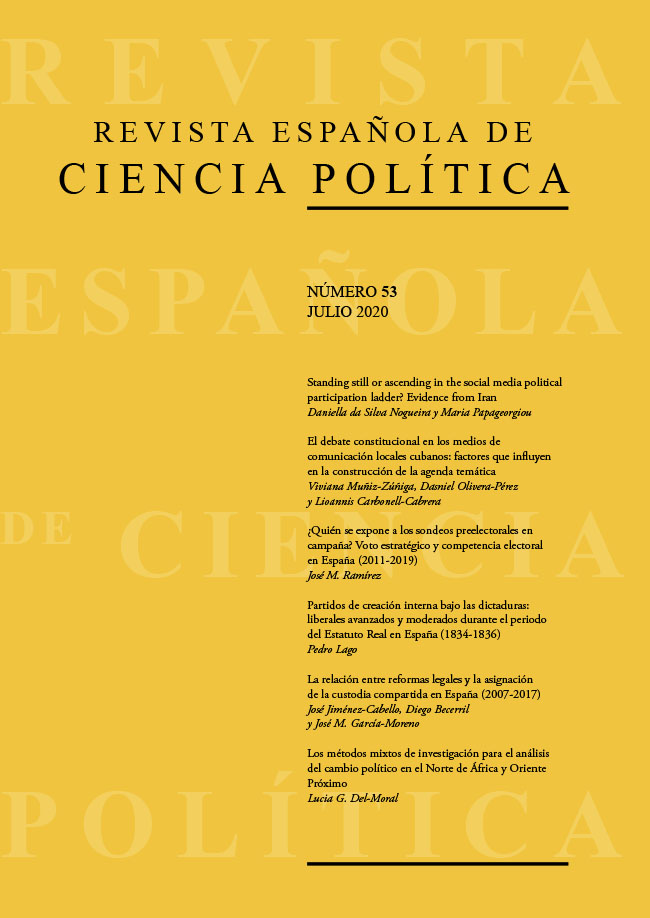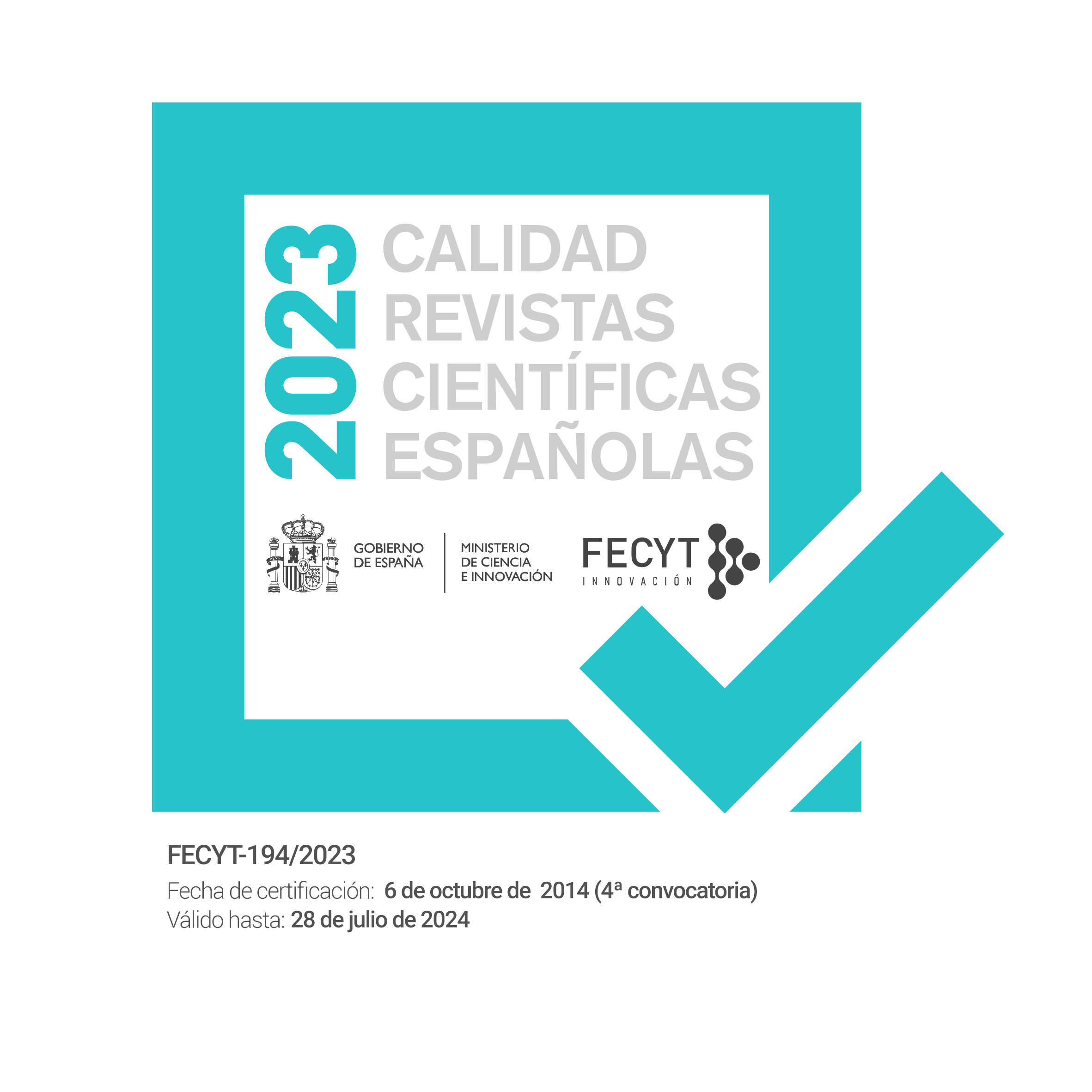Who is exposed to pre-election polls during the campaign? Strategic vote and electoral competition in Spain (2011-2019)
DOI:
https://doi.org/10.21308/recp.53.03Keywords:
electoral surveys, polling effects, strategic voting, electoral constituency, political communication, SpainAbstract
The increased relevance of pre-election polls in campaigns raises an interesting debate about their effects on voting. This article analyzes the type of voters who are exposed to the polls and the impact of the latter on those voters’ final decision. Based on data from post-electoral surveys by the Center for Sociological Research (CIS) for the general elections held in Spain in November 2011, December 2015 and April 2019, a statistical analysis model is presented to observe the people most likely to be exposed to polls and how the size of the constituency and internal electoral competition affect this consumption. The results show a transformation of voting decision mechanisms, that have been used as a source of information to develop a strategic vote, especially in the April 2019 elections. With the parliamentary entry of the right-wing populist party, VOX, and the consolidation of polarized pluralism in Spain, the data reveal a higher exposure in provinces with fewer seats and where electoral competition between parties is greater.
Downloads
References
Aalberg, Toril y Peter van Aelst. 2014. «Who Is Afraid of Preelection Polls? How Perceptions of Polls Influence Support for Polling Regulations among Elites», International Journal of Public Opinion Research, 26 (4): 517-530. Disponible en: https://doi.org/10.1093/ijpor/edt040.
Bandera López, Noel. 2016. «Qué precisión están teniendo los sondeos en el nuevo ciclo político? Elecciones europeas 2014 y autonómicas/municipales 2015», Empiria. Revista de Metodología de Ciencias Sociales, 34: 124-154. Disponible en: https://doi.org/10.5944/empiria.34.2016.16525.
Bhatti, Yosef y Rasmus T. Pedersen. 2016. «News Reporting of Opinion Polls: Journalism and Statistical Noise», International Journal of Public Opinion Research, 28 (1): 129-141. Disponible en: https://doi.org/10.1093/ijpor/edv008.
Blais, André, Elisabeth Gidengil y Neil Nevitte. 2006. «Do Polls Influence the Vote?», en Henry E. Brady y Richard Johnston (eds.), Capturing Campaign Effects. Ann Arbor: University of Michigan Press. Disponible en: https://doi.org/10.3998/mpub.132252.
Caballé, Adriá, Pere Grima y Llúis Marco-Almagro. 2013. «¿Aciertan los sondeos electorales? Análisis sobre la bondad de predicción de los sondeos electorales publicados en la prensa», Revista Española de Investigaciones Sociológicas, 143: 25-46. Disponible en: https://doi.org/10.5477/cis/reis.143.25.
Campbell, Rosie. 2013. Gender and the vote in Britain. Colchester: ECPR Press.
Cohen, Jonathan y Yariv Tsfati. 2009. «The Influence of Presumed Media Influence on Strategic Voting», Communication Research, 36 (3): 359-378. Disponible en: https://doi.org/10.1177/0093650209333026.
Cox, Gary W. 1997. Making Vote Count: Strategic Coordination in the World’s Electoral Systems. Cambridge: Cambridge University Press.
Dahlgaard, Jens O., Jonas H. Hansen, Kasper M. Hansen y Martin V. Larsen. 2016. «How are Voters Influenced by Opinion Polls? The Effect of Polls on Voting Behavior and Party Sympathy», World Political Science, 12 (2): 283-300. Disponible en: https://doi.org/10.1515/wps-2016-0012.
Dahlgaard, Jens O., Jonas H. Hansen, Kasper M. Hansen y Martin V. Larsen. 2017. «How Election Polls Shape Voting Behaviour», Scandinavian Political Studies, 40 (3): 330-343. Disponible en: https://doi.org/10.1111/1467-9477.12094.
Daoust, Jean-François, Claire Durand y André Blais. 2020. «Are Pre-Election Polls More Helpful than Harmful? Evidence from the Canadian Case», Canadian Public Policy, 46 (1): 175-186. Disponible en: https://doi.org/10.3138/cpp.2019-011.
Darmofal, David. 2010. «Reexamining the Calculus of Voting», Political Psychology, 31 (2): 149-174. Disponible en: https://doi.org/10.1111/j.1467-9221.2009.00754.x.
Delicado, Pedro, y Frederic Udina. 2001. «Cómo y cuánto fallan los sondeos electorales?», Revista Española de Investigaciones Sociológicas, 96: 123-150. Disponible en: https://doi.org/10.2307/40184386.
Delli Carpini, Michael. 1984. «Scooping the Voters? The Consequences of the Networks’ Early Call of the 1980 Presidential Race», The Journal of Politics, 46 (3): 866-885. Disponible en: https://doi.org/10.2307/2130859.
Donsbach, Wolfgang. 2001. Who’s Afraid of Election Polls? Normative and Empirical Arguments for the Freedom of Pre-Election Surveys. Amsterdam: Foundation for Information-Esomar.
Downs, Anthony. 1957. An economic theory of democracy. Nueva York: Harper and Row.
Duverger, Maurice. 1972. Los partidos políticos. México: Fondo de Cultura Económica.
Fleitas, Daniel W. 1971. «Bandwagon and Underdog Effects in Minimal-Information Elections», The American Political Science Review, 65 (2): 434-438. Disponible en: https://doi.org/10.2307/1954459.
Gasperoni, Giancarlo y Debora Mantovani. 2015. «The impact of exposure to pre-election polls on voting behaviour», Rivista Italiana di Scienza Politica, 45 (1): 1-23. Disponible en: https://doi.org/10.1017/ipo.2015.3.
Gelman, Andrew y King, Gary. 1993. «Why Are American Presidential Election Campaign Polls So Variable When Votes Are So Predictable?», British Journal of Political Science, 23 (4): 409-451.Disponible en: https://doi.org/10.1017/s0007 123400006682.
Grossi, Giorgio. 2007. La opinión pública. Teoría del campo demoscópico. Madrid: Centro de Investigaciones Sociológicas.
Hardmeier, Sibylle. 2008. «The Effects of Published Polls on Citizens», en Wolfgang Donsbach y Michael Traugott. (ed.), The SAGE Handbook of Public Opinion Research. Londres: SAGE Publications. Disponible en: https://dx.doi.org/10.4135/ 9781848607910.n48.
Harteveld, Eelco, Stefan Dahlberg, Andrej Kokkonen y Wouter Van Der Brug. 2019. «Gender Differences in Vote Choice: Social Cues and Social Harmony as Heuristics», British Journal of Political Science, 49 (3): 1141-1161. Disponible en: https://doi.org/10.1017/s0007123417000138.
Hernández Valdez, Alfonso. 2013. «Efectos, errores y regulación de las encuestas preelectorales: una política de transparencia para el caso mexicano», CONfines de Relaciones Internacionales y Ciencia Política, 9 (18): 59-85.
Hodgson, Robert y John Maloney. 2013. «Bandwagon effects in British elections, 1885-1910», Public Choice, 157: 73-90.
Holtz-Bacha, Christina y Jesper Strömbäck. 2012. Opinion polls and the media: reflecting and shaping public opinion. Londres: Palgrave Macmillan.
Hummel, Patrick. 2014. «Pre-election polling and third party candidates», Social Choice and Welfare, 42 (1): 77-98. Disponible en: https://doi.org/10.1007/s00355-013-0724-4.
Kiss, Áron y Gábor Simonovits. 2014. «Identifying the bandwagon effect in two-round elections», Public Choice, 160 (3): 327-344. Disponible en: https://doi.org/10.1007/ s11127-013-0146-y.
Lago, Ignacio. 2005. El voto estratégico en las elecciones generales en España (1977-2000). Madrid: Centro de Investigaciones Sociológicas.
Lau, Richard R. y David P. Redlawsk. 2006. How Voters Decide: Information Processing in Election Campaigns. Cambridge: Cambridge University Press.
Lavrakas, Paul, Jack Holley y Peter Miller. 1991. «Public reactions to polling news during the 1988 presidential election campaign», en Paul Lavrakas y Jack Holley (eds.), Polling and presidential election coverage. Newbury Park: Sage Publications.
Magallón, Raúl y José M. Sánchez Duarte. 2018. «Desafíos en la publicación de encuestas electorales. La relación entre empresas demoscópicas y medios de comunicación», Signo y Pensamiento, 37 (73). Disponible en: https://doi.org/10.11144/javeriana.syp37-73.dpee.
McAllister, Ian y Donley T. Studlar. 1991. «Bandwagon, Underdog, or Projection? Opinion Polls and Electoral Choice in Britain, 1979-1987», The Journal of Politics, 53 (3): 720-741. Disponible en: https://doi.org/10.2307/2131577.
Meffert, Michael F., Sascha Huber, Thomas Gschwend y Franz U. Pappi. 2011. «More than wishful thinking: Causes and consequences of voters’ electoral expectations about parties and coalitions», Electoral Studies, 30 (4): 804-815. Disponible en: https://doi.org/10.1016/j.electstud.2011.08.001.
Mehrabian, Lbert. 1998. «Effects of Poll Reports on Voter Preferences», Journal of Applied Social Psychology, 28 (23): 2119-2130. Disponible en: https://doi.org/ 10.1111/j.1559-1816.1998.tb01363.x
Montero, José R., Francisco Llera y Mariano Torcal. 1992. «Sistemas electorales en España: una recapitulación», Revista Española de Investigaciones Sociológicas, 58: 7-56. Disponible en: https://doi.org/10.2307/40183556.
Moreno, Cristina y Pablo Oñate. 2004. «Tamaño del distrito y voto estratégico en España». Revista Española de Investigaciones Sociológicas, 107: 123-151. Disponible en: https://doi.org/10.2307/40184641.
Morton, Rebecca B., Daniel Muller, Lionel Page y Benno Torgler. 2015. «Exit polls, turnout, and bandwagon voting: Evidence from a natural experiment», European Economic Review, 77: 65-81. Disponible en: https://doi.org/10.1016/j.euroecorev.2015.03.012.
Morwitz, Vicki G. y Carol Pluzinski. 1996. «Do Polls Reflect Opinions or Do Opinions Reflect Polls? The Impact of Political Polling on Voters’ Expectations, Preferences, and Behavior», Journal of Consumer Research, 23 (1): 53-67. Disponible en: https://doi.org/10.1086/209466.
Muñoz, Paloma y Alberto Mora. 2019. «Las encuestas electorales y sus efectos», Más Poder Local, 39: 9-13.
Nadeau, Richard, Richard G. Niemi y Timothy Amato. 1994. «Expectations and Preferences in British General Elections», The American Political Science Review, 88 (2): 371-383. Disponible en: https://doi.org/10.2307/2944710.
Noelle-Neumann, Elisabeth. 1974. «The Spiral of Silence. A Theory of Public Opinion», Journal of Communication, 24 (2): 43-51. Disponible en: https://doi.org/10.1111/j.1460-2466.1974.tb00367.x.
Noelle-Neumann, Elisabeth. 1984. The spiral of silence: public opinion, our social skin. Chicago; Londres: University of Chicago Press.
Obermaier, Magdalena, Thomas Koch y Christian Baden. 2017. «Everybody follows the crowd?», Journal of Media Psychology, 29 (2): 69-80. Disponible en: https://doi.org/10.1027/1864-1105/a000160.
Ocaña, Francisco y Pablo Oñate. 1999. «Índices e indicadores del sistema electoral y del sistema de partidos», Revista Española de Investigaciones Sociológicas, 86: 223-246. Disponible en: https://doi.org/10.2307/40184151.
Petersen, Thomas. 2012. «Regulation of Opinion Polls: a Comparative Perspective», en Christina Holtz-Bacha y Jesper Strömbäck (ed.), Opinion Polls and the Media: Reflecting and Shaping Public Opinion. Londres: Palgrave Macmillan.
Price, Vincent y Natali J. Stroud. 2005. «Public Attitudes toward Polls: Evidence from the 2000 U.S. Presidential Election», International Journal of Public Opinion Research, 18 (4): 393-421. Disponible en: https://doi.org/10.1093/ijpor/edh119.
Rich, Timothy S. 2015. «Strategic Voting and the Role of Polls: Evidence from an Embedded Web Survey», PS: Political Science and Politics, 48 (2): 301-305. Disponible en: https://doi.org/10.1017/s104909651400208x.
Sánchez-Cuenca, Ignacio. 2000. A Non-Strategic Explanation of Second Preference Voting. The Case of Spain. Juan March Institute Working Papers, 158. Madrid: Centro de Estudios Avanzados en Ciencias Sociales.
Sartori, Giovanni 1998. Homo videns. La sociedad teledirigida. Madrid: Taurus Ediciones.
Simon, Herbert A. 1954. «Bandwagon and underdog effects and the possibility of election predictions», Public Opinion Quarterly, 18 (3): 245-253. Disponible en: https://doi.org/10.1086/266513.
Stolwijk, Sjoerd B., Andreas R. T. Schuck, y Claes H. de Vreese. 2017. «How Anxiety and Enthusiasm Help Explain the Bandwagon Effect», International Journal of Public Opinion Research, 29 (4): 554-574. Disponible en: https://doi.org/10.1093/ijpor/edw018.
Van der Meer, Tom W. G., Armen Hakhverdian y Loes Aaldering 2016. «Off the fence, onto the bandwagon? A large-scale survey experiment on effect of real-life poll outcomes on subsequent vote intentions», International Journal of Public Opinion Research, 28 (1): 46-72. Disponible en: https://doi.org/10.1093/ijpor/edu041.
Downloads
- pdf (Español (España))
- html (Español (España))
- xml (Español (España))
- Gráfico 1 (Español (España))
- Gráfico 2 (Español (España))
- Gráfico 3 (Español (España))
- Gráfico 4 (Español (España))
- Gráfico 5 (Español (España))
- Gráfico 6 (Español (España))
- Tabla 1 (Español (España))
- Tabla 2 (Español (España))
- Tabla 3 (Español (España))
- Tabla 1 (Anexo) (Español (España))
Published
How to Cite
Issue
Section
License
Copyright (c) 2020 José María Ramírez Dueñas

This work is licensed under a Creative Commons Attribution-NonCommercial-NoDerivatives 4.0 International License.






